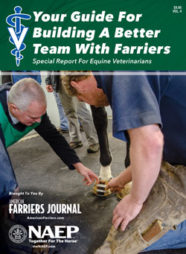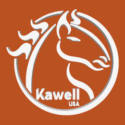The start of a new career path can be daunting. New horseshoeing school graduates understand this. Despite having the proper educational background, new farriers quickly learn that the education doesn’t stop once they receive their certificate of completion.
In 2008, American Farriers Journal established the “Rising Shoeing Star” program. Every year, this program highlights three recent horseshoeing school graduates who have successfully continued their career paths past graduation. This award was sponsored by Apex Tool Group/Diamond, Delta Mustad Hoofcare Center, G.E. Forge & Tool, Life Data Labs, Purcell Farrier Supply, Vettec and American Farriers Journal.
In 2012, Gwen Nardi of The Plains, Va., a 2008 graduate of the Kentucky Horseshoeing School (KHS) in Richmond, Ky., took home the top prize. Upon graduation, she became an intern at Forging Ahead in Round Hill, Va., where she focused on therapeutic horseshoeing. She followed this experience by joining the Virginia-Maryland Regional College of Veterinary Medicine at Virginia Tech (VMRCVM) as a podiatry intern. In 2010, Nardi became the youngest woman to become an American Farrier’s Association (AFA) certified journeyman farrier.
Here, Nardi shares the challenges she’s faced as a new farrier, the lessons she’s learned from established equine professionals and offers advice to farriers in training.
Q: What were the major obstacles you faced in getting started?
A:My gender and age were obstacles. Some farriers and horse owners heard “19 and female” and didn’t want to give me a chance, even though I graduated at the top of my class from KHS. It was also challenging to find the right apprenticeship. I knew that I wanted to continue my studies under someone who was accomplished and knowledgeable.
To overcome these challenges, I vowed to not give up until I landed the apprenticeship I wanted. I clearly defined my ultimate goal and what I was looking for in an apprenticeship. Then, I sought out farriers who I respected. I used the contacts from my school and other students who already landed their apprenticeships. I ended up finding my apprenticeship at Forging Ahead through a web listing.
New farrier graduates who are looking for apprenticeships need to remember that shoeing styles vary regionally, so when you apprentice in an area you’re going to learn that style. Do your best to find a farrier practice that specializes in the kind of shoeing you hope to do when you’re on your own.

Nardi receiving the “Rising Shoeing Star” award at 2012 International Hoof-Care Summit from American Farriers Journal Editor/Publisher Frank Lessiter.
Q: How did you spend the first 6 months after graduation?
A: I spent those months looking for an apprenticeship. I contacted farriers I knew and respected, followed up on referrals from KHS and scoured the Internet. I also advertised. I put up posters and business cards at farrier supply, hardware, feed and horse-supply stores. I called farriers I knew to see if they needed help with horses that were located farther away than they preferred to travel or that didn’t stand well.
Q: Looking back, what were the biggest mistakes you made? How can others avoid these problems?
A: I took a bit longer than I should have to decide where I wanted to set up shop. I wanted to make sure I could make a good living in the place I decided to live and work. I didn’t want to focus just on backyard horses, although they are wonderful clients. I wanted to work on competitive horses and on horses with hoof issues, too.
I also wasn’t open enough. I believed that there was only one correct style of shoeing. I try to stick to the English disciplines (hunters and jumpers, eventers, dressage) and serve horses with a wide range of needs, from simple trims for backyarders to therapeutic shoeing. I now know that better forging skills make for better shaping skills. Honing these skills helped me produce better shoes and work more efficiently.
This may sound unimportant, but it’s vital: wear hearing protection! In my everyday practice I always wear ear protection and safety goggles. I also keep a fire extinguisher mounted in my trailer and a first aid kit in my trunk.
Q: What were the three smartest moves you made in getting started?
A: To start, I think being selective and really going after what I want were smart moves on my part.
Second, securing and renewing an apprenticeship with Paul Goodness, CJF, was beneficial. He is a master farrier who runs a multi-farrier group in Round Hill, Va., called Forging Ahead. They work with everything from backyard horses to Olympic-level competitors. Goodness, who has been shoeing for over 30 years, has an innate ability to see a horse move and detect even the slightest imperfection, then correct it. It was an honor to work with such a talented group of farriers.
Lastly, when I finished school started the AFA certification process to prove to owners, my mentors and myself that I wanted to learn everything I could, from every perspective. Getting certified is a good way to demonstrate that you have the basics.
Q: What resources, other than your schooling, did you find most helpful and why?
A: I definitely found my apprenticeship at Forging Ahead the most helpful. I continued to maintain relationships with farriers I respected. I also kept reading textbooks to reinforce what I’d learned at KHS and to learn more about anatomy and shoeing practices from around the world. The International Hoof-Care Summit, AFA annual convention and other continuing education opportunities are also important.
Farriery is a lifelong education. New methods are always developing. Keeping up with innovations and new shoeing techniques is essential.
Q: What piece(s) of advice have you received that you find valuable?
A: AFA Examiner Danvers Child, CJF, a principal at Foxtail Forge & Farriery, a multi-farrier practice based in Lafayette, Ind., told me, “We have only so many horses in our bodies.” He stressed the importance of pacing myself and maintaining good health. In order to maintain myself and keep my entire body strong, I watch my diet and try to get to the gym at least four days a week.
I’ve also learned the critical importance of being a professional and establishing and never compromising my reputation. My name, business and reputation are on the line every time I trim or shoe a horse. Every horse is important, whether they graze the day away or compete at the highest level.
I bring that philosophy into every barn I work in. Farriery is a service profession. I set the bar high and work hard to never compromise my standards. So much of this business relies on word of mouth — it’s the best form of advertisement.
Q: What do you wish you would’ve and/or wouldn’t have done while you were still in school that would have benefited you after graduation?
A: I would have found the time to make contacts and shadow a range of farriers to learn different points of view. Also, while you’re in school, you have a very short time to learn all you need to know. The school must concentrate on the basics, so your shoeing time is pretty limited. I am a huge perfectionist, and while I’m not sure I would have changed anything to balance my workload better, I may have set firmer “hammers down” deadlines so that I could move on to the next assignment and finish before dawn. But, I would also encourage students to use their downtime to go out, see and do things around the area.
Q: What other suggestions do you have for graduates?
A: Aim high, maintain your integrity, work hard and never give up. I would suggest that no one should graduate farrier school and start their own practice right off the bat. There is just too much to know in the field. Farrier schools are fantastic, but they only have time to give you the basics. There is so much more to learn. So, find an apprenticeship and be open-minded. Realize there is so much to learn and use every second to build your experience.






